Construction of FDI frigates for the French and Greek navies
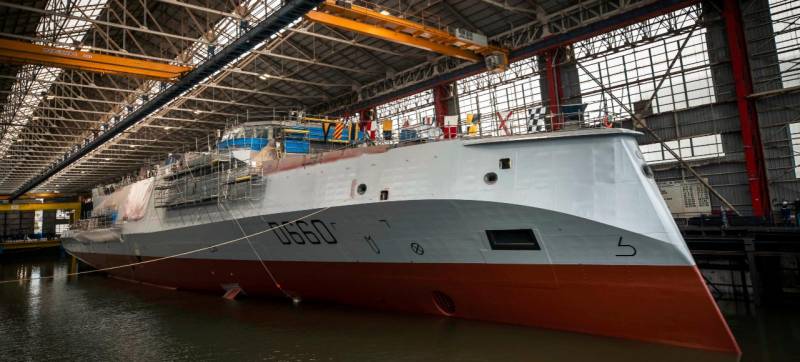
Frigate Amiral Ronarc'h D661 for the French Navy during launching, November 7, 2022
The French Naval Group is mastering the construction of promising FDI / FTI frigates and showing the first successes. In recent weeks, the first ship of this type was launched, and the second was also laid down. Before the end of the decade, the group will have to build at least eight new frigates for the French and Greek navies. In the future, an increase in the series due to the existing option and / or new contracts with third countries is not ruled out.
In the early stages
The decision to develop and build promising "medium frigates" FTI (Frégate de Taille Intermédiaire) was made by the French Ministry of Defense in 2013 as part of a new plan for military development and modernization of the armed forces. It was proposed to build five such ships, which in the distant future were to serve together with the multi-purpose frigates FREMM and Horizon.
The development of a new project, also designated FDI (Frégate de Défense et d'Intervention - "Defense and Intervention Frigate"), started in May 2015. At the first stage, the Navy and DCNS determined the tactical and technical requirements and shaped the look of the future frigate. According to the plans of that time, the construction of ships was to start by the end of the decade and be completed within the twenties.
In April 2017, DCNS, shortly before its transformation into the Naval Group, received a contract for the development of a technical design and construction of ships. The document, worth 2,1 billion euros, provided for the construction of five frigates - approx. 420 million euros for each. Construction was to begin by the end of the decade. The lead ship was planned to be commissioned by the mid-twenties.
In September 2021, Greece ordered various weapons and equipment from France with a total cost of approx. 5 billion euros. One of the signed contracts provided for the construction of three FDI frigates with an option for a fourth. Under the terms of the agreement, the ship as a whole will retain its original appearance, but will receive different weapons. The construction of the head pennant was planned for the first half of the decade.
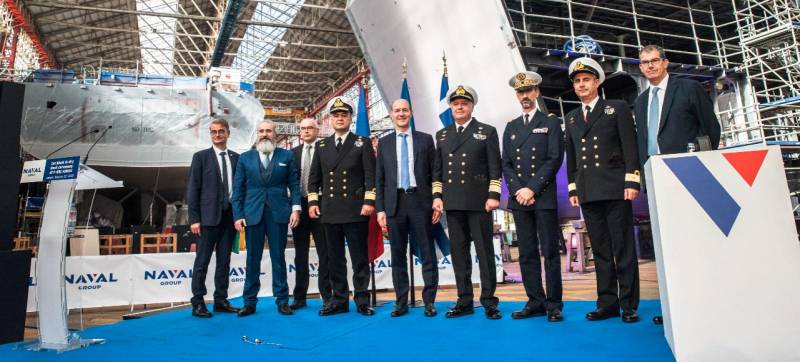
Laying of the head frigate "Κίμων" for the Greek Navy, October 21, 2022
Naval Group continues to search for new foreign customers. The export version of the frigate was named Belh @ rra (“Belharra”) - after the characteristic high wave observed on the coast of the Bay of Biscay. This project provides for the use of universal hull structures and energy and modular weapons. Equipment composition and weapons such a ship is chosen by the customer.
Completed work
The construction of FDI frigates for both customers was entrusted to DCNS Lorient (Lorient, Brittany). In 2017-20 the production facilities of the enterprise were reconstructed and modernized to meet new tasks and orders. As suppliers of various equipment, other French companies from various industries are involved in the production of ships.
In the near future, the Greek plant Salamis Shipyards will join the shipbuilding program. He will have to assemble individual blocks and sections, which will then be delivered to France for docking with locally produced structures. This method will be used starting with one of the following corpora.
In October 2019, the plant in Lorient began cutting metal for the lead ship, after which it proceeded to assemble the first structures. For a number of reasons, there was no hurry with the official laying of the ship. The solemn ceremony took place only on December 17, 2021. By this time, a fairly large section of the hull was on the slipway. The lead frigate for the French Navy received the tactical number D660 and the name Amiral Ronarc'h.
Over the past months, DCNS Lorient has completed the assembly of the hull and the main body of the superstructure. Inside the finished structures, some systems are installed and part of the communications are laid. In this form, the ship was taken out of the assembly shop on November 7, 2022 and launched. It was reported that in the coming days the ship would be transferred to the outfitting wall for further work. This was not done immediately due to bad weather conditions.
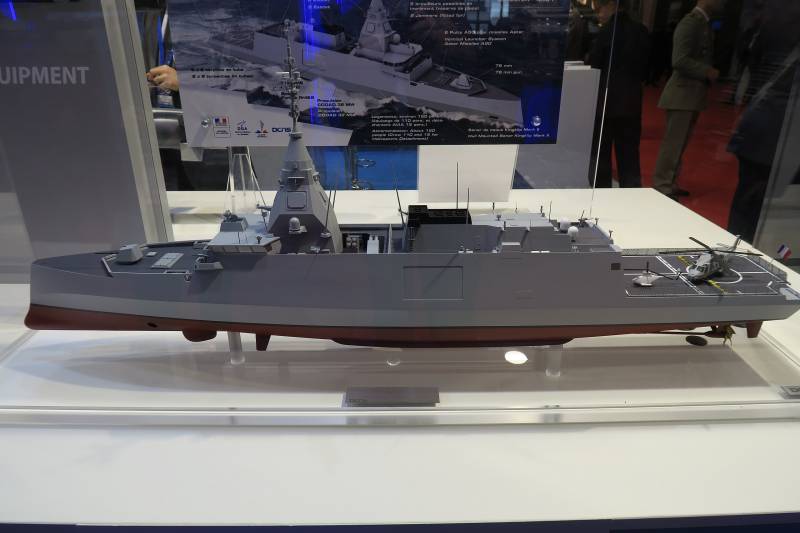
Ship layout FTI / FDI arr. 2016
In parallel with the work on the lead ship for France in Lorient, the construction of the first pennant for Greece was being prepared. The laying of this frigate, which received the name "Κίμων" ("Kimon") and the number F-601, took place recently - on October 21. A section of the hull was already present on the slipway, around which new structures will be built in the future. It has not yet been announced how long construction will take. It can be assumed that the ship will be launched next year.
Plans for the future
According to the announced plans, the installation of the remaining structures, equipment and weapons on the lead frigate for the French Navy will continue over the next few months. After that, "Admiral Ronark" will be tested. Entering the ship into combat fleet planned for the first months of 2024
The second frigate for France, Amiral Louzeau (D661), is still at the stage of cutting metal and assembling the first structures. Its laying will take place in the coming months or even weeks. The transfer to the customer is expected only at the beginning of 2026. It is curious that the Admiral Luzo will be handed over only after two ships for the Greek fleet.
The next three ships - Amiral Castex (D662), Amiral Nomy (D663) and Amiral Cabanier (D664) - have been contracted, but work on them has not yet begun. They will be laid only in the middle of the current decade and will be handed over in 2027-29.
The lead Greek "Kimon" (F-601) is already under construction, but it takes time to complete the work. According to the contract, in 2024 it will be tested, and at the beginning of 2025 it will begin service in the Greek Navy. The assembly of the structures of the second frigate F-602 "Νέαρχος" ("Nearkh") has also begun. Its bookmark can be expected in the coming months. The early start of full-fledged construction will make it possible to fulfill the plan and hand it over by the end of 2025.
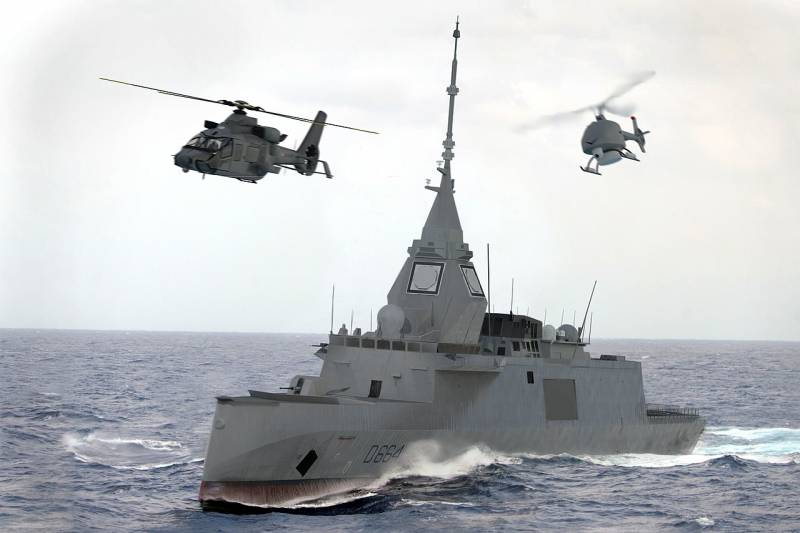
Expected appearance of ships
The frigate "Φορμίων" (F-603) is still in the plans for the future. It will be built after the completion of the assembly of several previous ships. However, the wait will not be long - the Formion will enter the Navy by the end of 2026. There is also a Greek option for a fourth ship, but its prospects are still unknown. His transfer to a firm contract depends on the success of ongoing work.
Technical features
The FDI / FTI project provides for the construction of a multi-purpose frigate capable of operating in the near and far sea zone, both independently and as part of warrants. The ship must perform the tasks of anti-aircraft and anti-submarine defense, as well as fight surface ships and coastal facilities.
The ship receives a hull with a characteristic stem littered back and traditional contours of the remaining parts. A low superstructure is provided, smoothly connected to the hull. There is a mast of radio-electronic equipment, part of weapons, etc. on it. The design length of such a frigate is 122 m with a width of 17,7 m. The normal displacement is 4460 tons. The crew is 110 people. Autonomy - 45 days.
The main power plant of the CODAD system was used, which includes several diesel engines with a total capacity of 32 MW. Depending on the current need, only a part of the engines or the entire installation together are working at the same time. Claimed maximum speed of 27 knots; cruising range - 5 thousand nautical miles.
The basis of electronic weapons is the Thales Sea Fire multifunctional radar with AFAR, which provides long-range all-round visibility. It also provides for various weapons control radars and the SENTINEL electronic warfare system. For PLO tasks, the Kingklip Mark 1115 hydroacoustic complex in the hull and the towed CAPTAS-4 are provided.
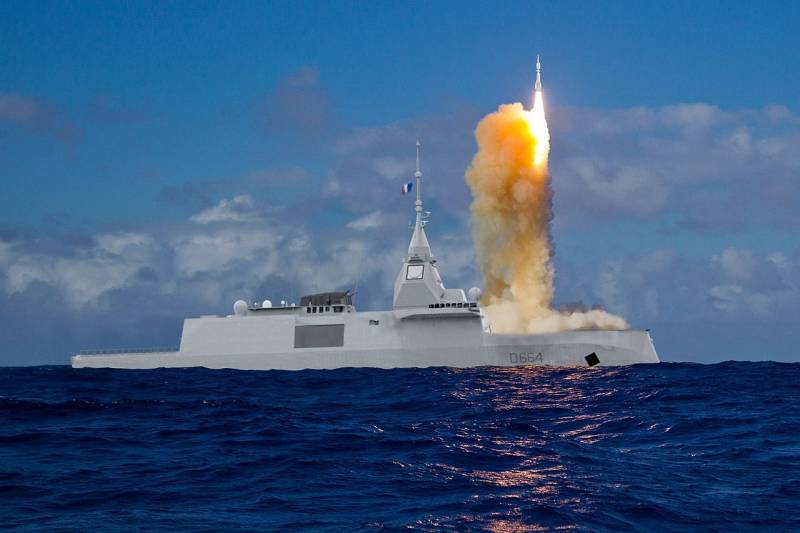
Launch of an Aster rocket from a nose mount
Frigates for France will receive a 76-mm Oto Melara Super Rapid artillery mount and a pair of Nexter Narwal mounts with 20-mm guns. The main strike tool will be Exocet missiles of the latest modification in the amount of 8 units. Air defense will be provided by MBDA Aster 15/30 missiles in two Sylver A50 installations - a total of 16 pieces. The ships will receive two twin 324 mm torpedo tubes.
Ships for Greece will receive similar artillery, anti-ship missiles and missiles. In this case, the composition of anti-aircraft weapons will be different. The number of Sylver A50 installations on Greek frigates will be increased to four with an increase in the ammunition load to 32 Aster missiles. They will be supplemented by the Mk 31 installation with 21 RIM-116 RAM Block 2A missiles.
In the stern of the ship are a landing pad and a hangar. French Navy frigates will each carry one NH90 or Guépard Marine helicopter. Greek ships will receive MR-60R Seahawk helicopters.
optimism and reality
Thus, the FDI's program of building medium-sized "defense and intervention" frigates is gradually gaining momentum and producing real results. Not so long ago, the first ship of this type was launched, and the construction of the next one began, and in the coming years, the laying of new pennants is expected. The navies of France and Greece are getting a reason for optimism.
However, we should not forget that the plans for the FDI program are scheduled until the end of the decade, and this is quite a long time. During this time, the situation may change, and the appearance of certain negative factors cannot be ruled out. They can force customers and contractors to revise plans and move the deadlines for work. Whether it will be possible to comply with the established schedule and get all the desired ships, time will tell.
Information